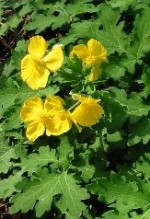 Wood poppy, also known as celandine poppy, offers abundant clusters of 2” wide bright yellow flowers, bluish-green divided leaves, and fuzzy seed pods. A native of rich woodlands and along stream banks it thrives in part to full shade, in loamy, moist soils and will go dormant if the soil dries out. It reseeds readily and will quickly naturalize and form attractive clumps. Wood poppy is one of the showiest wildflowers available, is easy to grow, and is a great addition to a shade or woodland garden. American Indians used the sap from the stems as a dye so it can also earn a place in an herb garden.
Wood poppy, also known as celandine poppy, offers abundant clusters of 2” wide bright yellow flowers, bluish-green divided leaves, and fuzzy seed pods. A native of rich woodlands and along stream banks it thrives in part to full shade, in loamy, moist soils and will go dormant if the soil dries out. It reseeds readily and will quickly naturalize and form attractive clumps. Wood poppy is one of the showiest wildflowers available, is easy to grow, and is a great addition to a shade or woodland garden. American Indians used the sap from the stems as a dye so it can also earn a place in an herb garden.
Type: Herbaceous perennial
Bloom: Buttercup yellow, 2” wide flowers are produced in clusters in spring
Foliage: Bluish-green lobed leaves.
Size: 18” H x 12” W
Light: Part to full shade
Soil: Loamy, moist
Fertilizer: Add well-rotted compost annually
Hardiness: Zones 4-9
Care: When transplanting place crown just below the soil level and keep very moist.
Pests and Diseases: None of importance
Propagation: Seed (plant ASAP so seeds do not dry out); division in spring or fall
Companion plants: Wild phlox (Phlox divaricate), white trillium (Trillium grandiflora), bloodroot (Sanguinaria canadensis), twinleaf (Jeffersonia diphylla),fringed bleeding heart (Dicentra exima), Virginia bluebells (Mertensia virginica), wild columbine (Aquilegia canadensis)foam flower (Tiarella cordifolia), false Solomon’s seal (Smilacina racemosa), male fern (Dryopteris filix-mas), New York fern (Thelypteris noveboracensis).
